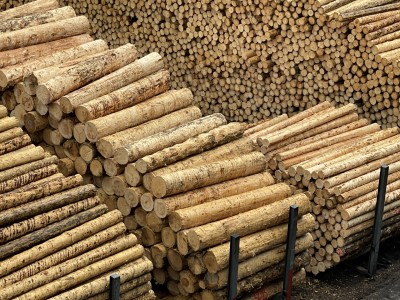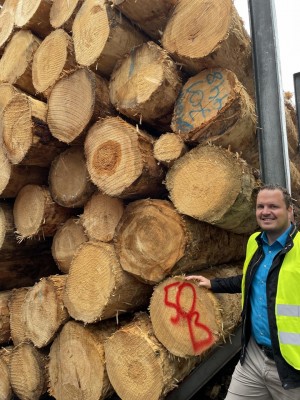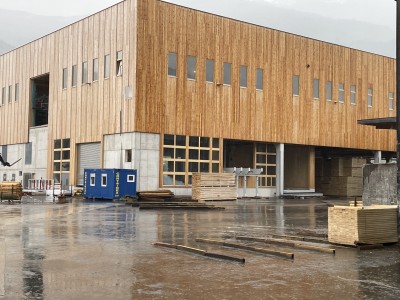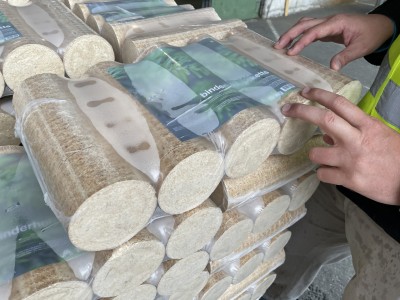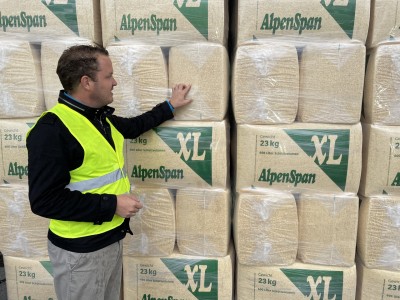In 2022, Austrian sawmills paid some of the highest timber prices in Europe. Still, they export lumber and wooden components to large building projects in the forestry nation Sweden. How is that possible? In a series of articles about the Austrian sawmilling company Binderholz, one of Europe’s most progressive companies in the sawmilling business, the sister site Skogsforum.se tries to explain this phenomenon.
So, this article is based on two of the Skogsforum-articles signed Torbjörn Johnsen meaning there will be at least one more later.
A family-owned success story
Austrian sawmills pay among the highest prices for timber in Europe. At the same time, Sweden has among Europe’s lowest timber prices. Still, companies like Binderholz in Austria export wooden components to Swedish building projects. How come?
Skogsforum.se decided to have a look at this and went to visit one of Binderholz’s sawmills. The original one where it all started in the 50s, in the alpine village of Fügen. Also, two CLT factories were visited during an intensive two-day trip. The trip’s goal was to discover the secrets behind their success.
Binderholz
The Binderholz sawmill in Fügen is squeezed in right in the center of the village. It’s a sawmill that produces 600 000 cubic meters of lumber annually. It makes you wonder how they can achieve that in such a limited area. The key is round-the-clock operation, planning, and clever solutions.
The company has grown significantly from a local lumberyard to today’s multinational enterprise. Apart from the Fügen sawmill, several other sawmills in Germany, Finland, Latvia, Great Britain, and the USA are included in the company. CLT-, glulam, and panel factories are also a part of Binderholz. All-in-all, over 5 million cubic meters of lumber are produced annually by the 6300 employees. With a slightly over 50 percent yield, almost 10 million cubic meters of timber is needed.
Only debarked timber in the timberyard
The timber from within the region is delivered by truck and railroad. The first thing that catches your eye, and that differs from Swedish sawmills, is that the timber is debarked immediately after unloading. The logs are sorted according to diameter and length into compartments. Compared to Swedish sawmills, few compartments are needed as mainly spruce is used, and only in three lengths. In Sweden, normally approx. 10 lengths are used which demands larger sorting facilities.
The debarked logs are stacked in the limited timberyard, waiting for the processing of their diameter class. No logs are stored for more than four weeks at a normal production pace. This demands just-in-time deliveries of timber all around the year. The production both in the sawmill and in the forest runs without a summer stop.
Thicker timber
An ocular inspection of the Binderholz timberyard reveals that the timber is thicker than in normal Swedish sawmills. There were stacks with logs over 60 centimeters (23,6 In.) in diameter. Most of the logs in the timberyard had a diameter of between 24 and 40 centimeters (9,4 – 15,7 In.). The Binderholz philosophy on log diameter is “the thicker the better”.
(Most Swedish sawmills have a price reduction for logs with a diameter of over 38 centimeters (15 In.). Logs over 75 centimeters (29,5 In.) in the root end, are not paid for at all. The highest prices you will get for logs of a diameter between 22 and 37 centimeters (8,7 – 14,5 In.) in the top end.)
The quality of the Austrian logs was however not so impressive. There were some good-looking, densely grown logs but most of it was fast-grown, knotty, and with lots of blue-stained and storage-damaged logs which didn’t seem to be a problem.
Traditional reducer saw
The sawmill in Fügen contains two saw lines. One traditional reducer line and one bandsaw line.
The reducer is a Linck line that is over 100 meters (328 Ft.) long. This line is very quick, and it can process logs of diameters up to 60 centimeters (23,6 In.). After this saw line the lumber is conveyed to green sorting, sticking, and kilning.
The bandsaw takes care of the sturdy logs. The bandsaw cut the logs into unedged planks. The good qualities are sold as such, and the rest was split in another saw into smaller dimensions. This simple and manual handling of logs is no problem for Binderholz. On the contrary, it gives the possibility to take large values out of each log. The yield is very high, and the quality is mostly good in the thick logs according to Christian Kolbitsch, marketing manager at Binderholz.
Round-the-clock operation
The fact that, compared to Swedish conditions, quite a small sawmill manages an annual production at the level of the largest Swedish sawmills could partly be explained by the round-the-clock operation. The debarking station is only allowed to operate during the daytime due to the noise, but the sawmill runs in three shifts. This gives a good utilization of the plant, but it also demands more resources for maintenance.
Another explanation is that the next bottleneck, the kilning, is divided into several other Binderholz plants. From the Fügen sawmill was e.g., green sorted lumber brought to the glulam factory in Jenbach a few miles away where it was kilned.
The planing mill
Within the sawmill area, there are, apart from the saw lines, kiln, and boiler, two planing mills. One older where construction lumber is milled and one new planing mill that is under construction. As the area is limited at the site, the new planing mill was built as a two-story building. In that way twice the working area is achieved on the same plot.
Pellets, pallets, and holistic thinking
Like any other sawmill, Bindeholz gets byproducts. Some of the green woodchips are sold to any of the few pulp mills in Austria. The bark is combusted at the plant with other residues and provides heat for the kilns, but also district heating for the village Fügen. Sawdust and green slabs go to pellet production or heating logs.
In pellet production, yet another example of the Binderholz philosophy is seen. To utilize everything and do as much as possible yourself: The operator monitoring the pellet packaging was also producing pallets from low-quality lumber at the same pace as the packaging robot needed them.
Dry shavings from the planer were baled and sold as horse bedding. Binderholz also packs pellets and horse bedding in packaging with the customer’s branding. Pallets made of pressed wood chips are also in the Binderholz product range.
Few lengths and only metric
Most of Europe uses the metric system, but the Swedish sawmills still use feet and inches, even though with some modifications to adapt to the metric system.
The Binderholz sawmills handle three lengths but in practice only two: sawlogs of four and five meters. Sometimes three-meter logs are purchased but there were none of those in the timberyard during our visit. Fewer lengths simplify the whole process from timber handling to lumber sorting. Binderholz sees no limitations in meeting the customer’s demands due to the few lengths.
The dimensions are sawn in even centimeters with planing measure. That is boards and planks that are 2, 3, 4, 5 … centimeters, and so on. Unplaned, including planing measure, that is 22, 32, 42, 52 … millimeters.
Mainly spruce
In Austria, Binderholz mainly processes spruce but also some pine, larch, and douglas fir. The Fügen mill, however, seems to be almost a pure spruce mill.
Some of the production from Fügen is delivered to the Binderholz glulam factory in Jenbach, the CLT factory in Unterberg, and the panel factory in St. Georgen. Other parts of the production are sold as different types of wood products, more or less processed.
Own shop and party venue
On the edge of the sawmill plot, in reach from the outside, is a combined restaurant, bar, and party/event/conference venue. Here you can get a bite to eat or a drink, and the Fügeners can rent it for a private party. According to Christian, the venue is often used for wedding parties and similar.
At the entrance is a shop, one of those you must pass when you’ve visited a museum or similar. Cool to have a shop at a sawmill! Here you can buy wood crafts, wine, schnaps, and more. Before the Covid -19 pandemic guided tours at the sawmill were offered. After the pandemic, this had to stop due to new security regulations at the mill. Something that Binderholz regrets. One must say the company lives in a tight symbiosis with the community.
The sawmilling philosophy
The goal for Binderholz is that its processing industry should be self-sufficient in wood from its own sawmills. Furthermore, another goal is that everything that comes from the industries should be taken care of and processed as much as possible. This goes for both the lumber and the residues (sawdust, chips, slabs, bark, etc.).
Binderholz GmbH (Ltd) has been very expansive and has purchased sawmills in many countries except Austria. Common to these sawmills is that their finances have been bad. Not necessarily due to the market but also because of the previous owners. In 2016, two sawmills were purchased in Finland from the state-owned company Vapo. In the US, Binderholz purchased two sawmills from the Austrian competitor Klaustner Group.
According to the Binderholz people Skogsforum met during the visit, the first priority is always to get a sawmill up and running with good profitability before further processing and company purchases are considered. The profitability includes taking care of all values that are handled (optimization and sorting) and optimizing the flow of residues.
Another goal is to develop products to meet the customer’s demands. If the customer wants a sustainable house panel, the first choice shouldn’t be North American cedar. Instead, Binderholz tries to develop new sustainable panel concepts based on what they produce in their own sawmills.
To be continued. Stay tuned!
In the meantime, you can read more about Binderholz GmbH on their home page here.









